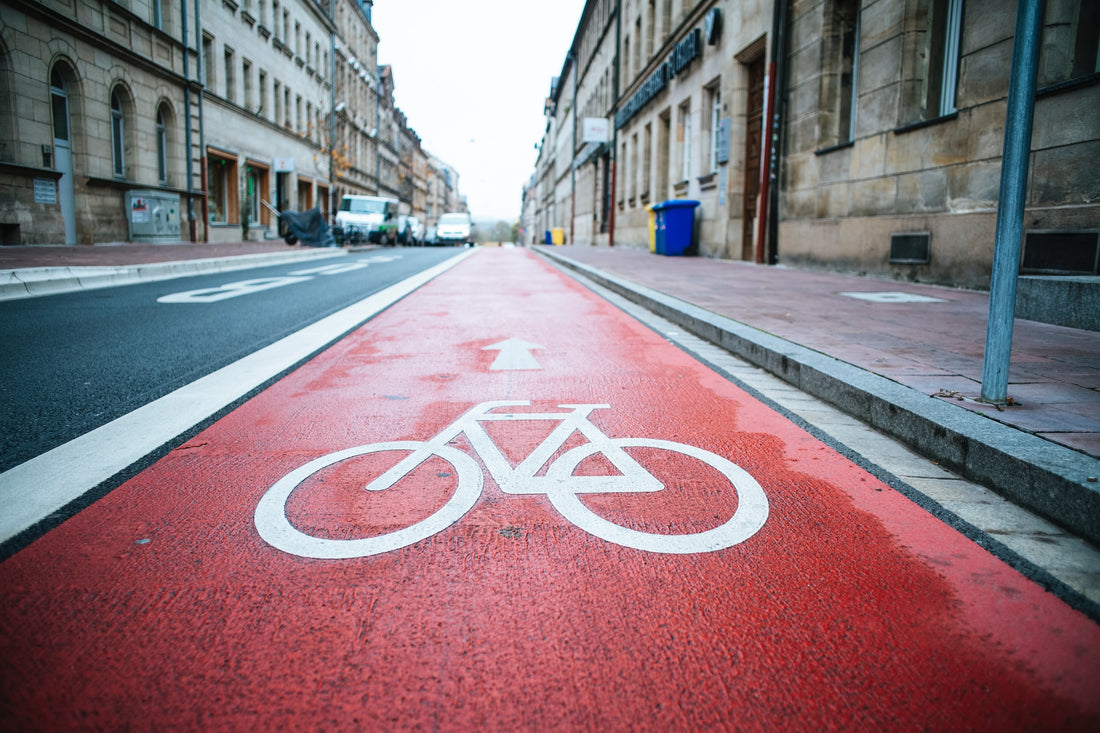Many of our cities and towns have been dominated by automobile infrastructure like streets, freeways, and parking structures that all take up considerable real estate. What if we were to repurpose just some of this real estate to bike and pedestrian paths to make our cities and towns more livable? Imagine the possibility of no traffic jams, no parking problems, and actually enjoying your commute to work….
Electric bikes turbocharge the capabilities of traditional bicycles, and make everyday riding very feasible and fun for many people to enjoy all the benefits of bike riding. It is not just individuals riding eBikes more, businesses of all sizes are getting into eBike deliveries which will need more bike infrastructure as well.
With more people riding and enjoying electric bikes the demand for safe and useful bike infrastructure will continue to grow. That new and different infrastructure has the power to transform cities.
A Special Kind of Vehicle
Electric bikes really are amazing vehicles with their ability to turbocharge your pedal power with electric assist to zip around town for commuting and errand running. They take the sting of hills and headwinds out of the equation to make everyday eBike riding very feasible for many people. Because eBikes that conform to the Class I, II, III ratings system are classified as a bicycle in most locations, they generally can take advantage of riding where traditional bikes travel (bike lanes and pathways), and they don’t require a license, registration, or insurance like a moped or motorcycle does.
Beyond the compelling pragmatic reasons, they are just a lot of fun to ride! Compared to electric cars and trucks, eBikes are an extremely affordable electric vehicle. When you add up all the benefits of an electric bike it becomes clear that they really are a special kind of vehicle blending utilitarian uses with affordability and pure fun.
Inspiration
Financial Times put together this video on the latest electric bike trends and also reminds us of what our cities were like before the automobile became so dominant:
New Kid on the Block
eBikes are still pretty new in many cities and towns and in many ways they are still finding their place. As with anything new there will be growing pains and some cities and towns have had to adapt to this new form of transportation in a hurry.
One area of eBikes that have had some issues is the eBike and eScooter share programs where they are left in areas that make it difficult for pedestrians or other bike riders to get around them. For instance; if they are left in the middle of a sidewalk.
Another area of concern is eBike riders riding too fast in crowded areas. This may be solved by rider etiquette reminders and speed limits for popular crowded pedestrian & bike paths.
These problems also have a positive flip side of more people out riding instead of driving thereby reducing pollution, traffic jams, and parking problems. When automobile infrastructure gets crowded and bogged down, the city, county, or state tends to expand it to meet the demand. We may see that with bike infrastructure demand as more people get out and ride on an electric bike.
Build It

So with more people riding maybe it is time to consider dedicating more infrastructure to biking and pedestrian use. As the image above conveys, the real estate required to transport 48 people around by bike is so much less than an automobile.
Cities are built for people but the infrastructure dedicated to automobiles has taken over so much real estate with streets, freeways, and parking structures. Even if just a small portion of that was repurposed for bicycle and pedestrian infrastructure it could make a big impact on how many people decide to start commuting by eBike.
This infrastructure doesn’t have to be brand new ground up construction, some of the existing automobile infrastructure can be repurposed to provide good bike routes. Here is an article that highlights repurposed rail lines and car lanes into bike pathways.
Portland, Oregon is a highlight in the US with 6.3% of the population commuting by bike as of 2017. They have 385 miles of bikeways with 100 more miles in the works. The approximate cost for all of the bike infrastructure in Portland is estimated to be the equivalent of 1 mile of urban freeway. Here are more interesting stats on Portland’s bike infrastructure.
The video above noted that some cities are providing more bike lanes that are wider for more users. Some European towns have dedicated eBike paths connecting them, for instance here is 62 mile bike highway connecting 10 cities and 4 universities in Germany. No cars on that highway!
Making Cities & Towns More Livable
Adding comprehensive bike and pedestrian infrastructure can make it safer for everyone; cyclists, pedestrians, and car drivers. By providing a safe route for each mode of transport it helps everyone feel more at ease knowing where they are supposed to be.
Having good bike and pedestrian infrastructure can make a place more livable by having a slower, human scale, and more connected ways of getting around a city or town. Instead of driving in a car that takes up a lot of space and tends to be sealed off from the outside, biking and walking is a much more engaging way of getting around and appreciating where you are.
In areas that focus more on bike and pedestrian transportation it is generally quieter and the air quality is better. For instance, a downtown that is less conducive to driving and more focused on biking and walking. Cities and towns with good biking and walking options tend to be popular for the locals as well as tourists. Some employers look to be located near bike routes to attract younger workers and/or customers.
The infrastructure also helps lower income commuters by giving them another option to safely bike or walk to work instead of spending more of their money on car or mass transit commuting.
Another benefit is the affordability of bike and pedestrian infrastructure compared to building automobile infrastructure; it is considerably less expensive. That is a nice savings for taxpayers and can help take some of the traffic burden off of the streets.
With more options for getting around by bike or walking it gives people more opportunities for getting regular exercise during the day which can improve the overall health of a community.
More eBike Deliveries, Less Vehicles on the Streets
Businesses are really getting into the idea of delivery by electric bike. In fact, the everyday eBike rider can get into the delivery work and start making money to ride their eBike! A pretty sweet deal.
There are restaurant delivery services like DoorDash, Uber Eats, Postmates, and others that have an eBike delivery option. Domino’s is hiring eBike riders for pizza deliveries and they supply the eBike.
Larger delivery companies like UPS, FedEx, DHL, USPS, Amazon, and others are getting into eCargo bike deliveries because the overall cost of the vehicle, fuel, and operational costs are low and in dense urban areas the deliveries can be quicker with no traffic jams and easier parking options.
Additionally, these businesses may benefit from more brand recognition because it is hard to ignore the site of an eCargo bike making deliveries! B-Line is a company in Portland, Oregon that makes local deliveries with their electric cargo trikes and also generates revenue from advertising on the side of the cargo box.
Delivery of goods by eBike takes cars, trucks, and vans off of the road which reduces pollution and frees up space on the roads, freeways, and parking areas. As more businesses get into delivery by electric bike the more bike infrastructure will be used and demanded.
eBikes Solving Problems
The electric bike is still a relatively new form of transportation but based on its popularity and versatility it looks like it can really hit the sweet spot of good transportation for many people, especially if there is safe and useful infrastructure.
And it is not just the individual rider looking for better bike infrastructure, it is also businesses that are using eBikes more and more for their deliveries. Cities and towns looking to the future of transportation need to look seriously at how the electric bike can solve many of the issues currently caused by the heavy focus on automobiles.
If you want better bike and pedestrian infrastructure, let your city or town transportation department know and vote for politicians who focus on these kinds of improvements.
Enjoy your rides!
-Pete




